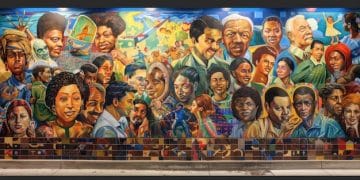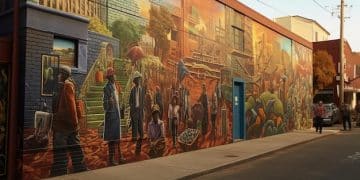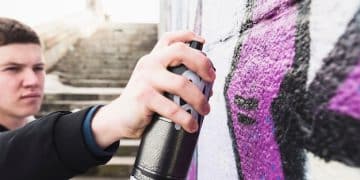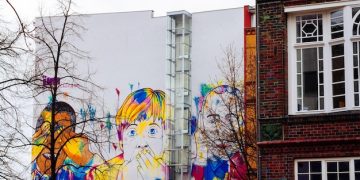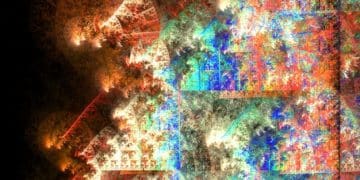Graffiti Art as Social Commentary: Messages Behind Murals
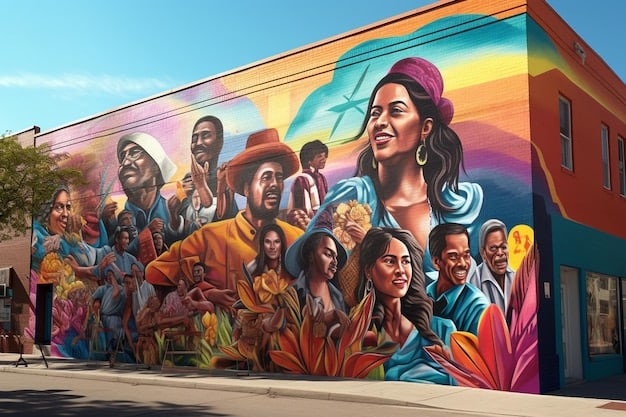
Examining graffiti art reveals its profound role as social commentary, transforming public spaces into canvases for powerful messages that reflect community voices and critique societal norms, offering unique insights into urban dialogue and cultural landscapes.
Delving into the vibrant world of graffiti art as social commentary: examining the messages behind the murals offers a unique lens through which to understand urban narratives and dissent. These powerful visual statements, often dismissed as mere vandalism, possess an inherent ability to communicate profound societal critiques.
The Genesis of Graffiti as a Social Voice
The evolution of graffiti from simple tags to complex murals reflects a potent desire for expression within marginalized communities. Initially, it served as a territorial marker or a display of artistic prowess, but it quickly transcended these boundaries to become a formidable tool for social and political discourse. This transformation was not accidental; it was driven by artists who recognized the power of public spaces to convey messages beyond the reach of traditional media.
Early Forms and Intentions
In its nascent stages, graffiti provided an outlet for individuals to assert their presence in an indifferent urban landscape. These early expressions, though rudimentary, laid the groundwork for a more sophisticated form of communication. The act of writing on walls, a defiant gesture against authority, inherently carried a subversive undertone.
* Territorial Claims: Gangs used tags to define their turf, thereby establishing unwritten rules of engagement in urban areas.
* Individual Recognition: “Writers” sought fame within their subculture, aiming for visibility and recognition through distinctive styles.
* Rebellion against Norms: The illegality of the act itself was a form of rebellion, challenging public order and property concepts.
This foundational period saw graffiti artists developing unique letterforms and styles, often influenced by the rhythmic beats and lyrical flows of hip hop culture, which was simultaneously burgeoning in urban centers. The raw energy and spontaneity characteristic of early graffiti mirrored the improvisational nature of rap music and breakdancing, creating a holistic cultural movement.
Transitional Phase: From Vandalism to Art
The shift from pure vandalism to a recognized art form began as artists refined their techniques and started embedding more complex narratives into their work. Murals began appearing, often depicting scenes or figures that resonated with the socio-economic struggles of the communities they inhabited. This period was marked by an increasing awareness among artists that their work could serve a higher purpose beyond personal recognition.
The transition was not without its challenges, facing strong opposition from municipal authorities and a skeptical public. However, the sheer persistence and undeniable artistic merit of some works slowly began to shift public perception. Galleries and art institutions, though initially hesitant, gradually started to acknowledge the cultural significance of graffiti, leading to a complex debate about its place in the art world. This debate continues, but it undeniable that graffiti has carved out a distinct and impactful niche.
The narratives within early murals often revolved around themes of poverty, police brutality, and systemic inequality, providing a visual chronicle of urban life that was rarely depicted in mainstream media. These works became a direct dialogue with the community, offering solace, provoking thought, and occasionally inciting action. It became clear that the walls were not just canvases, but megaphones for the unheard.
Murals as Mirrors: Reflecting Community Realities
Graffiti murals often serve as powerful reflections of the communities they inhabit, capturing the essence of their struggles, hopes, and identities. These large-scale artworks become public declarations, articulating concerns that might otherwise remain silenced or unheard. This direct form of communication fosters a sense of collective identity and shared experience among residents.
Addressing Social Injustice
Many murals directly confront issues of social injustice, acting as visual protests against systemic inequalities. From depicting scenes of police brutality to highlighting economic disparities, these artworks bring sensitive topics into public view, forcing onlookers to acknowledge uncomfortable truths. The stark realism and emotional depth often present in these pieces resonate deeply within the community, validating their experiences.
For example, murals portraying figures like George Floyd or Trayvon Martin emerged as powerful symbols of the Black Lives Matter movement, transforming urban walls into sites of remembrance and resistance. These images extend beyond mere representation; they become rallying points for collective grief and a demand for legal and social reform.
* Police Brutality: Images often depict confrontations with law enforcement, emphasizing the human cost of excessive force.
* Economic Inequality: Murals illustrate the disparity between the rich and the poor, often juxtaposing luxury with destitution.
* Racial Discrimination: Visually addressing stereotypes and prejudices, these artworks promote empathy and understanding.
* Immigration Issues: Narratives of displacement, struggle, and the search for belonging are frequently explored, giving voice to immigrant experiences.
The power of these murals lies in their accessibility; they do not require entry into a gallery or museum but exist openly in the public sphere, reaching a diverse audience. This democratizes art, allowing it to serve as a catalyst for discussion and change outside traditional venues.
Celebrating Cultural Heritage
Beyond critique, murals also play a crucial role in celebrating and preserving cultural heritage. They often feature historical figures, traditional symbols, or everyday scenes that are significant to a community’s identity. This visual affirmation helps to reinforce cultural pride, especially in areas where cultural narratives might be underrepresented or threatened.
Vibrant colors and intricate details are commonly used to capture the richness of diverse cultures, from indigenous traditions to immigrant histories. These artistic expressions ensure that cultural narratives are passed down through generations, maintaining a living history on the urban landscape.
Consider the detailed murals celebrating Mexican-American heritage in East Los Angeles or the vibrant Afrocentric art found in Harlem. These works are not merely decorative but serve as educational tools and sources of community empowerment, reminding residents of their roots and resilience. They stand as testaments to the enduring spirit of human creativity and cultural continuity.
The Language of the Street: Symbolism and Narratives
The visual language of graffiti art is rich with symbolism, turning commonplace urban elements into profound socio-political commentaries. Artists communicate complex ideas through a strategic use of imagery, color, and text, creating narratives that resonate deeply with local communities and beyond. Understanding this language is key to deciphering the messages behind the murals.
Decoding Visual Metaaphors
Graffiti artists often employ metaphors and allegories to convey their messages indirectly, yet powerfully. A seemingly simple image might carry layers of meaning, reflecting the artist’s perspective on societal issues. For instance, a broken chain could symbolize liberation from oppression, while a blooming flower in a desolate urban landscape might represent hope and resilience.
These visual metaphors require a degree of interpretation from the viewer, engaging them actively in the message. This interactive element makes the commentary more impactful and memorable. The artist doesn’t simply tell; they show, inviting thoughtful contemplation. Artists draw on both universal symbols and culturally specific imagery to ensure their message is understood by the intended audience, while also allowing for broader interpretations.
Color and Composition
The choice of colors and the overall composition of a mural are never arbitrary; they are integral to the message. Bright, contrasting colors might be used to demand attention or express urgency, while muted tones could convey somberness or reflection. The layout of figures and elements within the mural can guide the viewer’s eye, emphasizing certain aspects of the narrative.
A chaotic composition might reflect social unrest, whereas a balanced and harmonious arrangement could signal unity or a desire for peace. The scale of the mural itself—whether it covers an entire building or is confined to a smaller wall—also contributes to its impact, affecting how the message is perceived within the urban environment.
Text as a Direct Statement
While much of graffiti’s communication is visual, text plays a crucial role in delivering direct statements and slogans. These textual elements can range from simple tags and political slogans to poetic verses and impactful statistics. The typography and style of the lettering often add another layer of meaning, reflecting the tone and intensity of the message.
Phrases like “No Justice, No Peace” or “Housing is a Human Right” are common, providing unambiguous calls to action or declarations of belief. The combination of compelling visuals and direct text amplifies the overall social commentary, making the message both aesthetically engaging and intellectually stimulating.
Using text allows artists to be exceptionally clear when a nuanced visual message might be misinterpreted. It ensures the core sentiment is transmitted directly to passersby, grounding the abstract art in concrete demands or observations. This blend of explicit and implicit communication creates a multi-layered commentary that is both accessible and profound.
Graffiti’s Role in Urban Regeneration and Gentrification
The relationship between graffiti art and urban development, particularly regeneration and gentrification, is complex and often paradoxical. While graffiti can revitalize neglected spaces and foster community pride, its very presence can sometimes inadvertently pave the way for gentrification, displacing the very communities it aims to represent.
Art as a Catalyst for Change
Initially, street art often appears in disinvested neighborhoods, transforming derelict walls and abandoned buildings into vibrant canvases. This artistic intervention can inject new life into an area, making it more appealing and drawing attention to its unique character. The presence of compelling murals can attract visitors, artists, and investors, initiating a cycle of revitalization.
This artistic engagement can also empower local residents by providing a platform for their voices and stories, fostering a sense of ownership and collective identity. The art itself serves as a cultural beacon, signaling the area’s creative potential and its readiness for positive change.
The Double-Edged Sword of Gentrification
However, as an area gains popularity and becomes more appealing due to its burgeoning street art scene, property values often rise, leading to increased rents and living costs. This process, known as gentrification, can push out long-term residents and small businesses, fundamentally altering the social fabric of the neighborhood. The art that once spoke for the marginalized can then become a decorative facade for new, wealthier inhabitants.
The dilemma for artists is acutely felt: their work may contribute to the displacement of the very people they intended to champion. This tension has led to debates about the ethical responsibilities of street artists and the potential for their work to be co-opted by market forces.
* Increased Property Values: Areas with notable street art often see a rise in housing and commercial property prices.
* Displacement of Residents: Original residents, often low-income, are forced out due to unaffordable living costs.
* Loss of Unique Character: The raw, authentic feel of a neighborhood can be replaced by more commercialized and homogeneous aesthetics.
* Ethical Debates: Artists grapple with their role in urban change and whether their work contributes to displacement.
Preserving Authenticity Amidst Change
In response to these challenges, some artists and community groups actively seek to create art that resists gentrification or highlights its negative impacts. This can involve working directly with community organizations to ensure art projects genuinely benefit existing residents, or creating pieces that critique the very forces of displacement at play.
Efforts are also made to establish cultural districts or art zones that protect existing art and artists, aiming to retain the authentic spirit of an area even as it undergoes development. The conversation around urban regeneration needs to prioritize equitable development that respects and integrates the existing communities, rather than erasing them.
Graffiti and Its Legal and Ethical Dilemmas
The nature of graffiti inherently places it at the intersection of legality, ethics, and artistic freedom. Operating largely outside traditional art institutions and often on public or private property without permission, graffiti artists navigate a complex landscape of legal repercussions and moral considerations.
The Line Between Vandalism and Fine Art
One of the most persistent debates surrounding graffiti is where the line between vandalism and legitimate art should be drawn. From a legal standpoint, unauthorized markings on property are considered vandalism, leading to fines, arrests, and even jail time for artists. This legal framework reflects society’s emphasis on property rights and public order.
However, many argue that regardless of legality, the artistic merit and social commentary embedded in some graffiti works elevate them beyond simple vandalism. The skill, creativity, and profound messages often challenge the conventional definitions of art, pushing boundaries and sparking discussions about who gets to decide what constitutes art and where it should be displayed.
Ethical Considerations for Artists
Artists themselves face ethical dilemmas. While some embrace the defiant nature of illegal street art as essential to its authenticity and power, others seek permission or work on commissioned pieces, attempting to legitimize their practice. The choice often reflects their personal philosophy on art, activism, and the responsibility to the communities whose walls they adorn.
There’s also the question of impact on the community. While a mural might convey a powerful message, if it’s painted on a private business or residence without consent, it can cause problems for property owners who then bear the cost and effort of removal. This tension highlights the ongoing conflict between artistic expression and community standards.
* Property Rights: The fundamental conflict arises from the unauthorized use of private or public property.
* Public Perception: How the public views graffiti—as blight or beauty—significantly impacts its acceptance.
* Artist Responsibility: Debates exist about artists’ responsibility to gain consent or choose appropriate locations.
The Role of Permission and Commissioned Works
A growing trend sees cities, businesses, and charitable organizations commission graffiti artists for sanctioned projects. This shift often involves artists working legally on designated walls, turning them into official public art spaces. While this approach bypasses legal issues, some critics argue it dilutes the rebellious and raw essence of traditional graffiti.
However, commissioned works allow for larger scales, greater creative freedom without the pressure of illegality, and can integrate murals more effectively into urban planning. They also offer a pathway for artists to earn a living from their craft, fostering a sustainable ecosystem for street art that bridges the gap between the underground and the mainstream.
This evolving dynamic suggests a future where graffiti can coexist within different legal frameworks, continuing to serve as both an audacious form of social commentary and a celebrated form of public art. The challenge lies in balancing artistic freedom with urban governance to enrich public spaces equitably.
The Global Impact of Graffiti as a Commentary
Graffiti’s influence as a form of social commentary extends far beyond local urban neighborhoods, resonating globally and transcending cultural and geographic boundaries. Its ability to communicate complex messages universally has made it a powerful medium for protest, solidarity, and cultural exchange across continents.
From Local Walls to Global Movements
What begins on a local wall in one city can quickly become a symbol for a global movement, thanks to the pervasive power of social media and digital dissemination. Images of powerful murals addressing issues like climate change, human rights, or war can go viral, connecting people across borders and inspiring similar expressions of dissent and hope elsewhere.
Artists like Banksy, whose cryptic and often politically charged works appear in diverse locations worldwide, exemplify this global reach. His art challenges viewers to question authority and societal norms, proving that powerful messages can transcend language barriers when presented visually. The anonymity of some global artists also adds an intriguing layer to their commentary.
Cross-Cultural Dialogue
Graffiti acts as a visual lingua franca, fostering cross-cultural dialogue by addressing universal human experiences and struggles. Themes of oppression, freedom, and resilience are understood regardless of the specific cultural context in which they are created, facilitating empathy and solidarity among diverse populations.
In post-conflict zones, murals often become expressions of collective memory and healing, while in highly developed nations, they might critique consumerism or isolation. This adaptability allows graffiti to remain relevant and impactful across a vast spectrum of societal realities.
* Political Protest: Used to articulate dissent against authoritarian regimes or specific government policies worldwide.
* Environmental Activism: Murals highlight climate change, pollution, and conservation efforts, raising global awareness.
* Human Rights Advocacy: Depicting issues of inequality, justice, and dignity for marginalized groups globally. It amplifies voices and promotes solidarity.
Digital Street Art and Accessibility
The advent of digital media has profoundly impacted graffiti’s global reach and accessibility. Digital platforms allow a mural painted on a remote wall to be viewed by millions worldwide instantaneously, bypassing traditional art distribution channels. This has democratized access to the art form and amplified its capacity for social commentary.
Documentaries, online galleries, and social media channels dedicated to street art ensure that the messages behind the murals are not confined to their physical locations. This digital footprint transforms ephemeral art into lasting statements, contributing to an ongoing global conversation about art, society, and change. The accessibility of digital tools has also lowered the barrier to entry for aspiring artists, further diversifying the voices that emerge from the street.
The Future of Graffiti as a Social Commentary
The trajectory of graffiti art as a vehicle for social commentary suggests a dynamic and evolving future, influenced by technological advancements, changing urban landscapes, and shifting societal concerns. Its adaptability and inherent rebellious spirit ensure its continued relevance.
Technological Integration
The increasing integration of technology will likely shape the future of graffiti. Augmented reality (AR) and virtual reality (VR) could transform how murals are experienced, adding layers of information, animation, or interactive elements. Imagine a mural that, when viewed through a smartphone, reveals historical context or animated sequences that amplify its message.
Projection mapping could also allow transient, large-scale displays of art and messages on buildings without permanent alteration, offering a flexible and adaptable medium for commentary. This blend of traditional spray paint with digital innovation presents exciting possibilities for artists to engage with their audience in novel ways. The digital realm provides a new frontier for street artists to experiment with concepts of temporality and scale.
Adapting to Urban Landscapes
As cities continue to evolve, so too will the canvases available for graffiti. From abandoned industrial spaces to meticulously planned urban parks, artists will find new venues and methods to express their views. The growing trend of legal street art districts and mural programs suggests a future where authorized spaces coexist with illicit acts of expression, fostering a diverse ecosystem for the art form.
Artists might increasingly focus on sustainable materials or environmentally conscious practices, reflecting global concerns about ecological impact. The art itself could become more integrated with urban planning, acting as a visual narrative woven into the very fabric of city life. This includes art that responds directly to urban architectural forms, utilizing existing structures as integral parts of the composition.
Responding to New Global Challenges
The social commentary embedded in graffiti will undoubtedly continue to reflect and respond to emerging global challenges. As societies grapple with issues like climate change, artificial intelligence, and global health crises, artists will use their platforms to interpret these complexities, provoke thought, and inspire action.
The immediate and visceral nature of street art makes it uniquely suited to address pressing contemporary issues, providing a raw and unfiltered perspective that often cuts through mainstream narratives. Its democratic accessibility ensures that these discussions are not confined to elite forums but are brought directly to the public square.
Ultimately, the future of graffiti as social commentary lies in its enduring capacity to give voice to the voiceless, to challenge norms, and to illuminate the hidden truths of society. It will continue to be a vibrant, audacious, and indispensable part of the urban dialogue, adapting its forms while retaining its core function as a mirror reflecting the human condition. Its resilience and evolution are testaments to its power.
| Key Aspect | Brief Description |
|---|---|
| 🎨 Medium of Expression | Graffiti evolved from tags to murals, becoming a powerful tool for social and political discourse in public spaces. |
| 🗣️ Social Commentary | Murals reflect community realities, addressing issues like social injustice, inequality, and cultural heritage. |
| 💡 Symbolism & Narrative | Artists use visual metaphors, color, and text to create layered narratives that engage viewers actively. |
| 🌍 Global Impact & Future | Graffiti influences global movements, fosters cross-cultural dialogue, and integrates new technologies for future expression. |
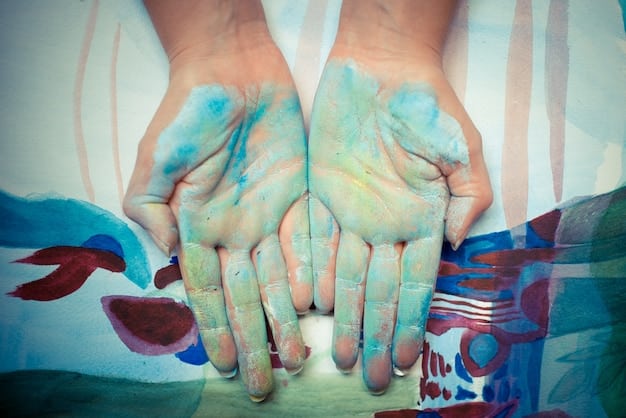
Frequently Asked Questions About Graffiti Art as Social Commentary
▼
Graffiti art functions as social commentary when its visual elements, messages, or placement critique, advocate for, or reflect on societal issues, political landscapes, and community experiences. It transcends mere aesthetic appeal to deliver a message directly to the public, often representing the voice of marginalized groups or expressing collective sentiments about current events and injustices.
▼
Graffiti art profoundly impacts urban environments by transforming dilapidated spaces into vibrant cultural canvases. It can contribute to urban regeneration by attracting attention and fostering a creative atmosphere. However, it also introduces complexities related to property rights and gentrification, sometimes inadvertently leading to the displacement of the very communities it aims to represent and uplift.
▼
While much of graffiti historically originates from unauthorized markings, not all graffiti is illegal. There’s a growing trend of commissioned murals and designated legal walls where artists can create without legal repercussions. This distinction highlights the complex relationship between artistic expression, urban policy, and public acceptance, blurring the lines between art and vandalism.
▼
Artists convey messages through a strategic combination of visual metaphors, symbolism, color choices, and direct textual elements. They often use allegorical figures, cultural symbols, and emotionally charged imagery to explore complex themes. The placement and scale of the mural also contribute significantly to its communicative power, ensuring the message resonates with passersby.
▼
Graffiti’s global impact is substantial, serving as a universal visual language for protest and solidarity across cultures. Through digital media, murals can quickly go viral, amplifying messages about human rights, political dissent, and environmental issues worldwide. It fosters cross-cultural dialogue by addressing universal human experiences and inspiring activism on an international scale.
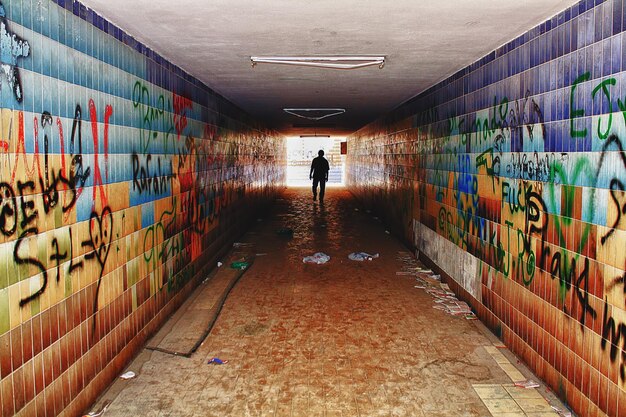
Conclusion
The exploration of graffiti art as social commentary unveils a profound and intricate dialogue between art, urban spaces, and societal consciousness. Far from being mere defacement, these murals serve as visceral expressions of collective sentiment, reflecting the struggles, hopes, and identities of communities often overlooked by mainstream narratives. They push the boundaries of artistic expression while simultaneously confronting pressing social and political issues. As urban landscapes continue to evolve and global challenges intensify, the role of graffiti art as a powerful, accessible, and often defiant form of social commentary will undoubtedly grow, solidifying its place not just within hip hop culture, but as an indispensable component of contemporary public discourse. Its enduring legacy lies in its capacity to transform walls into megaphones, giving voice to the voiceless and provoking vital conversations that resonate far beyond the streets they adorn.
